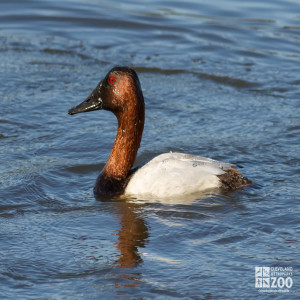Canvasback
[Aythya valisineria]

Canvasback ducks measure 19 to 24 inches and weigh 3 to 5.6 pounds. Males have a dark reddish head and neck, grading to blackish on the face and crown. The mid-back is white with brownish black on the rump and upper tail coverts. The underparts are white with some black. Females have the same color head as males, but with more buff around the eyes and on the cheeks. Most of the upperparts are dark brown. The canvasback is primarily a fresh water pochard or diving duck and is not adept at walking on land. Its feet are farther back on the body and have large webs.
Location: Animals Formerly at Zoo
Share:
Range
The range of the canvasback duck is from Central Alaska to northern California, east to Minnesota, and they winter in southern California and the Pacific and Atlantic Coasts to southern Mexico.
Habitat
Canvasback ducks inhabit shallow prairie marshes.
Conservation Status
Least ConcernPrimary Threats
Human - Wildlife ConflictGestation
Incubation: 24-25 days
Litter
Clutch: 9-10 bright olive eggs
Behavior
Canvasback ducks are active during the day. They are highly social, and they migrate seasonally between breeding and non-breeding ranges. They migrate in loose V-shaped flocks and are one of the fastest flying ducks. They have to run along the water for some distance before they can take flight. Canvasbacks are efficient and powerful swimmers, with their legs positioned near the rear of their body. They may spend up to 20% of the day swimming and can dive to over 29 feet deep for 10 to 20 seconds
Reproduction
Canvasback ducks are seasonally monogamous. Courtship begins during the spring migration and continues on the breeding grounds. Males and females generally remain with a partner during the season, although occasionally males have extra pair copulations or abandon a first mate for a second. Females use courtship displays to assess male quality, especially male ability to compete for food and space. During the height of courtship, receptive females are periodically surrounded by 3 to 8 males in "courting parties." There are a variety of courtship displays: the neck-stretch, incite behavior, a male sneak approach, kinked-neck, head-throw, and turning the back of the head. All are used to start and enforce the pair bond.
Wild Diet
Submerged aquatic vegetation, clams, crabs and small invertebrates
